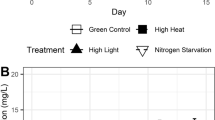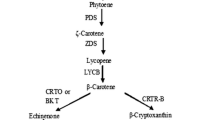Abstract
The unicellular green algaHaematococcus pluvialis has recently attracted great interest due to its large amounts of ketocarotenoid astaxanthin, 3,3′-dihydroxy-β,β-carotene-4,4′-dione, widely used commercially as a source of pigment for aquaculture. In the life cycle ofH. pluvialis, astaxanthin biosynthesis is associated with a remarkable morphological change from green motile vegetative cells into red immotile cyst cells as the resting stage. In recent years we have studied this morphological process from two aspects: defining conditions governing astaxanthin biosynthesis and questioning the possible function of astaxanthin in protecting algal cells against environmental stress. Astaxanthin accumulation in cysts was induced by a variety of environmental conditions of oxidative stress caused by reactive oxygen species, intense light, drought, high salinity, and high temperature. In the adaptation to stress, abscisic acid induced by reactive oxygen species, would function as a hormone in algal morphogenesis from vegetative to cyst cells. Furthermore, measurements of bothin vitro andin vivo antioxidative activities of astaxanthin clearly demonstrated that tolerance to excessive reactive oxygen species is greater in astaxanthin-rich cysts than in astaxanthin-poor cysts or astaxanthin-less vegetative genesis and carotenogenesis, and the accumulated astaxanthin in cysts can function as a protective agent against oxidative stress damage. In this study, the physiological roles of astaxanthin in stress response and cell protection are reviewed.
Similar content being viewed by others
References
Benemann, J. R. (1992) Microalgae aquaculture feeds.J. Appl. Phycol. 4: 233–245.
Terao, J. (1989) Antioxidant activity of β-carotene-related carotenoids in solution.Lipids 24: 659–661.
Palozza, P. and N. I. Krinsky (1992) Astaxanthin and canthaxanthin are potent antioxidants in a membrane model.Arch. Biochem. Biophys. 297: 291–295.
Kobayashi, M. and Y. Sakamoto (1999) Singlet oxygen quenching ability of astaxanthin esters from the green algaHaematococcus pluvialis.Biotechnol. Lett. 21: 265–269.
Guerin, M., M. E. Huntley, and M. Olaizola (2003)Haematococcus astaxanthin: Applications for human health and nutrition.Trends Biotechnol. 21: 210–216.
Johnson, E. A. and G.-H. An (1991) Astaxanthin from microbial sources.Crit. Rev. Biotechnol. 11: 297–326.
Kobayashi, M., T. Kakizono, and S. Nagai (1991) Astaxanthin production by a green alga,Haematococcus pluvialis accompanied with morphological changes in acetate media.J. Ferment. Bioeng. 71: 335–339.
Johnson, E. A. and W. A. Schroeder (1995) Microbial carotenoids.Adv. Biochem. Eng. Biotechnol. 53: 119–178.
Grung, M., F. M. L. D’Souza, M. Borowitzka, and S. Liaaen-Jensen (1992) Algal carotenoids 51. Secondary carotenoids 2.Haematococcus pluvialis aplanospores as a source of (3S,3′S)-astaxanthin esters.J. Appl. Phycol. 4: 165–171.
Borowitzka, M. A., J. M. Huisman, and A. Osborn (1991) Culture of the astaxanthin-producing green algaHaematococcus pluvialis: 1. Effect of nutrients on growth and cell type.J. Appl. Phycol. 3: 295–304.
Boussiba, S. and A. Vonshak (1991) Astaxanthin accumulation in the green algaHaematococcus pluvialis.Plant Cell Physiol. 32: 1077–1082.
Lee, Y.-K. and S.-Y. Ding (1994) Cell cycle and accumulation of astaxanthin inHaematococcus lacustris (Chlorophyta).J. Phycol. 30: 445–449.
Kobayashi, M., Y. Kurimura, T. Kakizono, N. Nishio, and Y. Tsuji (1997) Morphological changes in the life cycle of the green algaHaematococcus pluvialis.J. Ferment. Bioeng. 84: 94–97
Kobayashi, M., T. Kakizono, and S. Nagai (1993) Enhanced carotenoid biosynthesis by oxidative stress in acetate-induced cyst cells of a green unicellular alga,Haematococcus pluvialis.Appl. Environ. Microbiol. 59: 867–873.
Kobayashi, M., T. Kakizono, N. Nishio, and S. Nagai (1992) Effects of light intensity, light quality, and illumination cycle on astaxanthin formation in a green alga,Haematococcus pluvialis.J. Ferment. Bioeng. 74: 61–63.
Kobayashi, M., N. Hirai, Y. Kurimura, H. Ohigashi, and Y. Tsuji (1997) Abscisic acid-dependent algal morphogenesis in the unicellular green algaHaematococcus pluvialis.Plant Growth Regul. 22: 79–85.
Kobayashi, M., Y. Kurimura, and Y. Tsuji (1997) Light-independent astaxanthin production by the green micro-algaHaematococcus pluvialis under salt stress.Biotechnol. Lett. 19: 507–509.
Tjahjono, A. E., Y. Hayama, Y. Kakizono, Y. Terada, N. Nishio, and S. Nagai (1994) Hyper-accumulation of astaxanthin in a green algaHaematococcus pluvialis at elevated temperatures.Biotechnol. Lett. 16: 133–138.
Schroeder, W. A. and E. A. Johnson (1993) Antioxidant role of carotenoids inPhaffia rhodozyma.J. Gen. Microbiol. 139: 907–912.
Shaish, A., M. Avron, U. Pick, and A. Ben-Amotz (1993) Are active oxygen species involved in induction of β-carotene inDunaliella bardawil? Planta 190: 363–368.
Kobayashi, M., T. Kakizono, N. Nishio, S. Nagai, Y. Kurimura, and Y. Tsuji (1997) Antioxidant role of astaxanthin in the green algaHaematococcus pluvialis.Appl. Microbiol. Biotechnol. 48: 351–356.
Kobayashi, M. (2000)In vivo antioxidant role of astaxanthin under oxidative stress in the green algaHaematococcus pluvialis.Appl. Microbiol. Biotechnol. 54: 550–555.
Kobayashi, M. (2001) Algal carotenoid biosynthesis enhanced by active oxygen under environmental stress.Protein, Nucleic Acid and Enzyme 46: 2073–2077 (in Japanese).
Kobayashi, M., T. Kakizono, K. Yamaguchi, N. Nishio, and S. Nagai (1992) Growth and astaxanthin formation ofHaematococcus pluvialis in heterotrophic and mixotrophic conditions.J. Ferment. Bioeng. 74: 17–20.
Britton, G. (1988) Biosynthesis of carotenoids. pp. 133–182. In: T. W. Goodwin (ed.).Plant Pigments. Academic Press, London, UK.
Fraser, P. D., Y. Miura, and N. Misawa (1997).In vitro characterization of astaxanthin biosynthetic enzymes.J. Biol. Chem. 272: 6128–6135.
Cunningham, F. X. and E. Gantt (1998) Genes and enzymes of carotenoid biosynthesis in plants.Annu. Rev. Plant Physiol. Plant Mol. Biol. 49: 557–583.
Moran, J. F., M. Becana, I. Iturbe-Ormaetxe, S. Frechilla, R. V. Klucas, and P. Aparicio-Tejo (1994) Drought induces oxidative stress in pea plants.Planta 194: 346–352.
Price, A. H., N. M. Atherton, and G. A. F. Hendry (1989) Plants under drought-stress generate activated oxygen.Free Rad. Res. Comms 8: 61–66.
Zeevaart, J. A. D. and R. A. Creelman (1988) Metabolism and physiology of abscisic acdi.Annu. Rev. Plant Physiol. Plant Mol. Biol. 39: 439–473.
Hirsch, R., W. Hartung, and H. Gimmler (1989) Abscisic acid content of algae under stress.Bot. Acta 102: 326–334.
Yoshida, K., E. Igarashi, M. Mukai, K. Hirata, and K. Miyamoto (2003) Induction of tolerance to oxidative stress in the green alga,Chlamydomonas reinhardtii, by abscisic acid.Plant Cell Environ. 26: 451–457.
Young, A. J. (1991) The photoprotective role of carotenoids in higher plants.Physiol. Plant. 83: 702–708.
Santos, M. F. and J. F. Mesquita (1984) Ultrastructural study ofHaematococcus lacustris (Girod.) Rostafinski (Volvocales): I. Some aspects of carotenogenesis.Cytologia 49: 215–228.
Kobayashi, M. and T. Okada (2000) Protective role of astaxanthin against UV-B irradiation in the green algaHaematococcus pluvialis.Biotechnol. Lett. 22: 177–181.
Johnson, E. A. and W. A. Schroeder (1996) Biotechnology of astaxanthin production inPhaffia rhodozyma.ACS Sym. Ser. 637: 39–50.
Fukuzawa, K., Y. Inokami, A. Tokumura, J. Terao, and A. Suzuki (1998) Rate constants for quenching singlet oxygen and activities for inhibiting lipid peroxidation of carotenoids and α-tocopherol in liposomes.Lipids 33: 751–756.
Simidzu, N., M. Goto, and W. Miki (1996) Carotenoids as singlet oxygen quenchers in marine organisms.Fish. Sci. 62: 134–137.
Halliwell, B. and J. M. C. Gutteridge (1989)Free Radicals in Biology and Medicine. 2nd ed. Oxford University Press, Oxford, UK.
Bass, D. A., J. W. Parce, L. R. Dechatelet, P. Szejda, M. C. Seeds, and M. Thomas (1983) Flow cytometric studies of oxidative product formation by neutrophils: A graded response to membrane stimulation.J. Immunol. 130: 1910–1917.
Malanga, G. and S. Puntarulo (1995) Oxidative stress and antioxidant content inChlorella vulgaris after exposure to ultraviolet-B radiation.Physiol. Plant. 94: 672–679.
Collén, J. and I. R. Davison (1997)In vivo measurement of active oxygen production in the brown algaFucus evanescens using 2′,7′-dichlorohydrofluorescein diacetate.J. Phycol. 33: 643–648.
Sandmann, G. (1994) Carotenoid biosynthesis in microorganisms and plants.Eur. J. Biochem 223: 7–24.
Misawa, N. and H. Shimada (1998) Metabolic engineering for the production of carotenoids in non-carotenogenic bacteria and yeasts.J. Biotechnol. 59: 169–181.
Margalith, P. Z. (1999) Production of ketocarotenoids by microalgae.Appl. Microbiol. Biotechnol. 51: 431–438.
Boussiba, S. (2000) Carotenogenesis in the green algaHaematococcus pluvialis: Cellular physiology and stress response.Physiol. Plant. 108: 111–117.
Schoefs, B., N.-E. Rmiki, J. Rachadi, and Y. Lemoine (2001) Astaxanthin accumulation inHaematococcus requires a cytochrome P450 hydroxylase and an active synthesis of fatty acids.FEBS Lett. 500: 125–128.
Kajiwara, S., T. Kakizono, T. Saito, K. Kondo, T. Ohtani, N. Nishio, S. Nagai, and N. Misawa (1995) Isolation and functional identification of a novel cDNA for astaxanthin biosynthesis fromHaematococcus pluvialis, and astaxanthin synthesis inEscherichia coli.Plant Mol. Biol. 29: 343–352.
Lotan, T. and J. Hirschberg (1995) Cloning and expression inEscherichia coli of the gene encoding β-C-4-oxygenase, that converts β-carotene to the ketocarotenoid canthaxanthin inHaematococcus pluvialis.FEBS Lett. 364: 125–128.
Linden, H. (1999) Carotenoid hydroxylase fromHaematococcus pluvialis: cDNA sequence, regulation and functional complementation.Biochim. Biophys. Acta 1446: 203–212 (1999).
Grünewald, K., J. Hirschberg, and C. Hagen (2001) Keto-carotenoid biosynthesis outside of plastids in the unicellular green algaHaematococcus pluvialis.J. Biol. Chem. 276: 6023–6029.
Steinbrenner, J. and H. Linden (2001) Regulation of two carotenoid biosynthesis genes coding for phytoene synthase and carotenoid hydroxylase during stress-induced astaxanthin formation in the green algaHaematococcus pluvialis.Plant Physiol. 125: 810–817.
Bouvier, F., R. A. Backhaus, and B. Camara (1998) Induction and control of chromoplast-specific carotenoid genes by oxidative stress.J. Biol. Chem. 273: 30651–30659.
Nievelstein, V., J. Vandekerckhove, M. H. Tadros, J. V. Lintig, W. Nitschke, and P. Beyer (1995) Carotene desaturation is linked to a respiratory redox pathway inNarcissus pseudonarcissus chromoplast membranes: Involvement of a 23-kDa oxygen-evolving-complex-like protein:Eur. J. Biochem. 233: 864–872.
Tan, S., F. X. Cunningham, M. Youmans, B. Grabowski, Z. Sun, and E. Gantt (1995) Cytochromef loss in astaxanthin-accumulating red cells ofHaematococcus pluvialis (Chlorophyceae): Comparison of photosynthetic activity, photosynthetic enzymes, and thylakoid membrane polypeptides in red and green cells.J. Phycol. 31: 897–905.
Steinbrenner, J. and H. Linden (2003) Light induction of carotenoid biosynthesis genes in the green algaHaematococcus pluvialis: Regulation by photosynthetic redox control.Plant Mol. Biol. 52: 343–356.
Tjahjono, A. E., T. Kakizono, Y. Hayama, N. Nishio, and S. Nagai (1994) Isolation of resistant mutants against carotenoid biosynthesis inhibitors for a green algaHaematococcus pluvialis, and their hybrid formation by protoplast fusion for breeding of higher astaxanthin producers.J. Ferment. Bioeng. 77: 352–357.
Chumpolkulwong, N., T. Kakizono, T. Handa, and N. Nishio (1997) Isolation and characterization of compactin resistant mutants of an astaxanthin synthesizing green algaHaematococcus pluvialis.Biotechnol. Lett. 19: 299–302.
Tripathi, U., G. Venkateshwaran, R. Sarada, and G. A. Ravishankar (2001) Studies onHaematococcus pluvialis for improved production of astaxanthin by mutagenesis.World J. Microbiol. Biotechnol. 17: 143–148.
Chen, Y., D. Li, W. Lu, J. Xing, B. Hui, and Y. Han (2003) Screening and characterization of astaxanthin-hyperproducing mutants ofHaematococcus pluvialis.Biotechnol. Lett. 25: 527–529.
Tjahjono, A. E., T. Kakizono, Y. Hayama, and S. Nagai (1993) Formation and regeneration of protoplast from a unicellular green algaHaematococcus pluvialis.J. Ferment. Bioeng. 75: 196–200.
Teng, C., S. Qin, J. Liu, D. Yu, C. Liang, and C. Tseng (2002) Transient expression oflacZ in bombarded unicellular green algaHaematococcus pluvialis.J. Appl. Phycol. 14: 495–500.
Nonomura, A. M. and D. M. Coder (1988) Improved phycocatalysis of carotene production by flow cytometry and cell sorting.Biocatalysis 1: 333–338.
Kobayashi, M., T. Katsuragi, and Y. Tani (2001) Enlarged and astaxanthin-accumulating cyst cells of the green algaHaematococcus pluvialis.J. Biosci. Bioeng. 92: 565–568.
An, G.-H., J. Bielich, R. Auerbach, and E. A. Johnson (1991) Isolation and characterization of carotenoid hyper-producing mutants of yeast by flow cytometry and cell sorting.Bio/Technol. 9: 70–73.
Rabbani, S., P. Beyer, J. von Lintig, P. Hugueney, and H. Kleinig (1998) Induced β-carotene synthesis driven by triacylglycerol deposition in the unicellular algaDunaliella bardawil.Plant Physiol. 116: 1239–1248.
Lorenz, R. T. and G. R. Cysewski (2000) Commercial potential forHaematococcus microalgae as a natural source of astaxanthin.Trends Biotechnol. 18: 160–167.
Spiller, G. A. and A. Dewell (2003) Safety of an astaxanthin-richHaematococcus pluvialis algal extract: A randomized clinical trial.J. Med. Food 6: 51–56.
Kobayashi, M. (2002) Astaxanthin production byHaematococcus.Seibutsu-Kogaku 80: 244–246 (in Japanese).
Author information
Authors and Affiliations
Corresponding author
Rights and permissions
About this article
Cite this article
Kobayashi, M. Astaxanthin biosynthesis enhanced by reactive oxygen species in the green algaHaematococcus pluvialis . Biotechnol. Bioprocess Eng. 8, 322–330 (2003). https://doi.org/10.1007/BF02949275
Received:
Accepted:
Issue Date:
DOI: https://doi.org/10.1007/BF02949275




